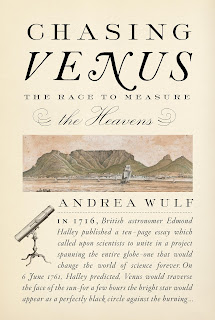In 1716, sixty-year old Sir Edmund Halley called on astronomers all over the world to leave their cozy observatories, travel to the edges of the known world, set up their telescopes, and turn their eyes toward the sunrise on the morning of June 6th, 1761, when the first
Transit of Venus of the scientific age would march across the face of the sun.
In the eighteenth century, the solar system had a shape but not a size.
 |
| Captain Cook's 1792 Drawing |
By timing the entrance and the exit of Venus across the sun from latitudes all over the world, Halley explained, astronomers could roughly calculate the distance between the Earth and the Sun — a “celestial yardstick” for measuring the universe, as
Andrea Wulf calls it in her excellent book
Chasing Venus: The Race to Measure the Heavens.
 |
| 1882 Film of Venus transit |
It was the first worldwide scientific collaboration of its kind, a mathematical olympiad six hours in duration, with years of planning and seconds that counted.
Today, more than 250 years after this grand experiment that required astronomers all over the world to gather together and look to the sky at the exact same moment, we will experience the last transit of our lifetime (unless modern medicine makes us survive to December 2117, when the next one will take place).









No comments:
Post a Comment